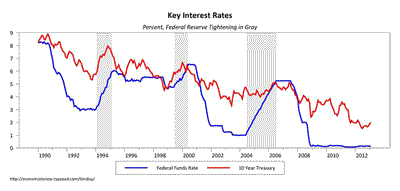Today’s FOMC statement and subsequent press conference by Federal Reserve Chairman Ben Bernanke reaffirmed the general view that the Fed will keep short-run interest rates locked down until 2015. It should be expected that the same is not true for long-rates. If communications are effective, we would expect long rates to rise well ahead of the date of the first increase in the federal funds target.
Consider Bernanke’s reference to 1994 in his recent speech:
We also have some historical experience with increases in rates during tightening cycles to consider. For example, in 1994, 10-year Treasury yields rose about 220 basis points over the course of a year, reflecting an unexpected quickening in the pace of economic growth and signs of building inflation pressures. This increase in long-term rates appears to have reflected a mix of a pronounced rise in the expected path of the policy interest rate and some increase in the term premium…our approach to communicating and implementing monetary policy provides the Federal Reserve with new tools that could potentially be used to mitigate the risk of sharp increases in interest rates. In 1994–the period discussed earlier in which sharp increases in interest rates strained financial markets–the FOMC’s communication tools were very limited; indeed, it had just begun issuing public statements following policy moves.
Fed officials are concerned that the exit strategy is not as disruptive for bond market participants as the 1994 episode. Looking back at the last three major tightening periods:
(click to enlarge)
In 1994, almost all of the increase in long rates occurred during the tightening itself. In the subsequent episodes, long rates increased only 66bp (99-00) and 60bp (04-06) during the tightening episodes themselves. Long rates bottomed well ahead of the Fed rate increase, in late 1998 with the Asian Financial Crisis and with the Fed’s last rate cut in 2003. At those times, financial market participants began to anticipate that the Fed would soon change course and begin implementing tighter strategy.
Better communication in the latter two periods compared to 1994 helped foster a smoother implementation of policy. And communication tools have only improved since the 04-06 tightening. Consequently, we should expect that much of the increase in long-rates will occur before the Fed pulls the trigger on short-rates. That lead-in will prevent the Fed’s exit from being as disruptive as many people seem to fear.
- Bulenox: Get 45% to 91% OFF ... Use Discount Code: UNO
- Risk Our Money Not Yours | Get 50% to 90% OFF ... Use Discount Code: MMBVBKSM
Disclaimer: This page contains affiliate links. If you choose to make a purchase after clicking a link, we may receive a commission at no additional cost to you. Thank you for your support!




Leave a Reply